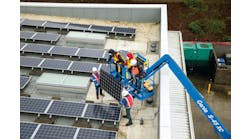Industrial production in manufacturing increased 0.9 percent in May, seasonally adjusted, and was 7.9-percent higher than May 2009, the Federal Reserve reported this week. “Gains in semiconductor manufacturing equipment and construction machinery have contributed significantly to the improvement in the industrial and other equipment category,” Federal Reserve officials said. “Within nonindustrial supplies, the output of construction supplies increased 0.8 percent in May after two consecutive months of larger gains.”
The value of new nonresidential construction starts in January through May 2010 combined increased 9.8 percent compared to the same period in 2009, according to Reed Construction Data. May starts jumped 16 percent compared with April, not seasonably adjusted, “a little more than the usual seasonal gain,” according to Reed chief economist Jim Haughey.
“The value of starts has now been about steady for three months after allowing for seasonality,” added Haughey. “Current starts are 50 percent above the low point last June but remain 25-percent below the pre-recession peak. Heavy projects starts rose 20 percent from April in line with the usual seasonal trends and were off 20 percent from the stimulus-boosted peak last August. May nonresidential building starts were 14 percent above April, reversing that month’s decline. Typically there is very little seasonal pickup in May. Although off by 3.6 percent last month, institutional starts remain relatively high. Commercial starts jumped 52 percent from an unusually weak April but remain more depressed than institutional starts. There was a significant May rebound in all commercial categories except hotels, which slipped a further 40 percent.”
Housing starts dropped 10 percent in May to a seasonally adjusted annual rate of 593,900 units, the slowest pace since December 2009, according to the Census Bureau.





